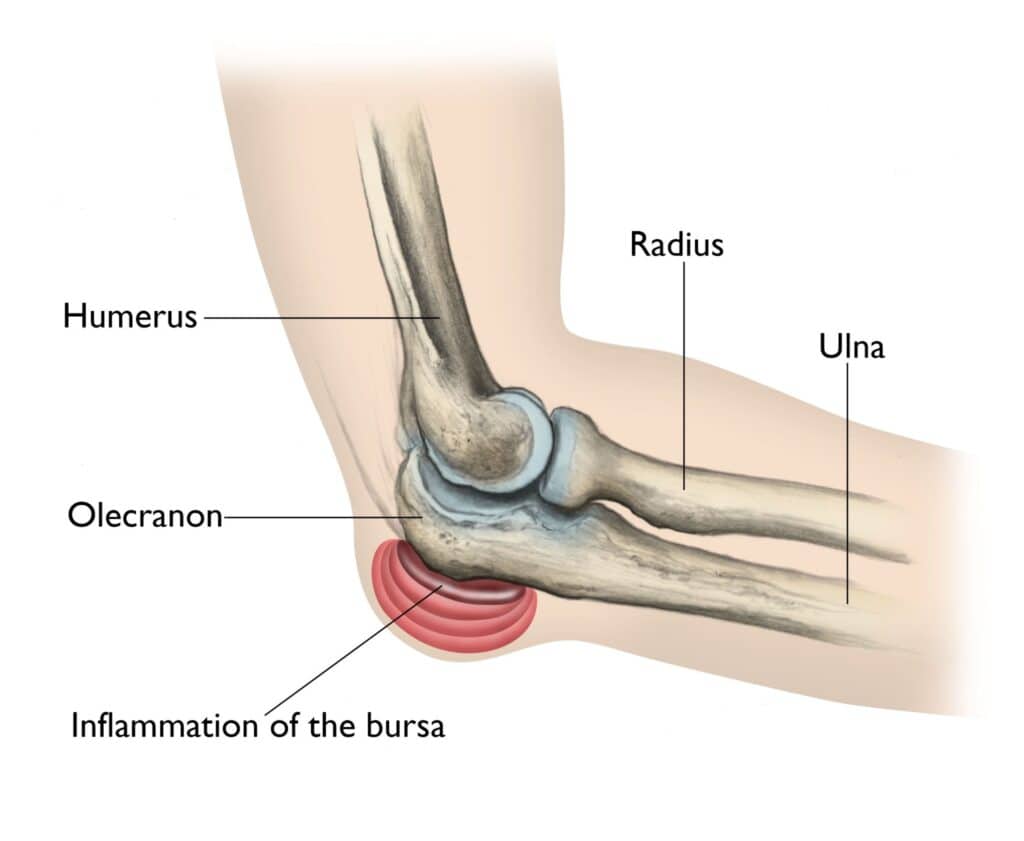Many conditions can cause elbow swelling. In general, these conditions can be considered either trauma (related to injury), or atraumatic (not related to injury).
Amongst the most common cause of atraumatic elbow swelling is olecranon bursitis. This refers to swelling that occurs as a result of inflammation in the cushioning tissue of the elbow, which is known as the olecranon bursa.
Sometimes, this swelling can be a result of a hard knock on the elbow, but most commonly, it is not directly related to the injury. Atraumatic causes of olecranon bursitis include,
What are the symptoms of olecranon bursitis?
The most common complaint of olecranon bursitis is elbow swelling. Generally, patients do not notice the swelling until it is too large. These occasionally become so large that they might restrict elbow movements, or become injured due to the patient hitting them against something accidentally.

In addition to swelling at the elbow, the condition can also be painful. This is sometimes related to the recurrent knocks on the enlarged bursa. It can also be painful for the patient to lean against the elbow
The olecranon bursa can sometimes appear red and angry and feel warm to touch. Patients may also have a fever, and sometimes a spot that looks like a pimple may appear. This suggests that the olecranon bursa may have gotten infected. Inflammatory conditions such as gout can sometimes cause similar swellings in the olecranon bursa.
How is olecranon bursitis related to gout?
Gout is the most common cause of olecranon bursitis. Gout is a type of inflammatory arthritis that can develop in any joint of the body, though it occurs most commonly in the big toe. When your body has an increased level of uric acid (a waste product found in the blood), you may develop symptoms of gout. The uric acid crystals can appear within the olecranon bursa, causing swelling that is painful and red. The elbow is frequently also painful to move.
How is olecranon bursitis diagnosed?
Based on your history, the doctor will conduct a focused medical examination on the elbow, focusing on the area of swelling. He/She may also order X-rays of the elbow to determine if there is an underlying bone spur, which may be related to bursitis.
If the bursa is very large, fluid can sometimes be extracted for analysis. This may help to confirm the diagnosis of gout or provide clues as to whether there is an infection in the bursa.
How can I treat olecranon bursitis?
Depending on the cause and severity of the olecranon bursitis, treatment options may vary. Small bursae that are not infective in nature may be treated with non-surgical methods, whereas infected/large bursae and bursae unresponsive to conservative treatment may require surgery.
Non-surgical
Activity modification – very frequently the cause of olecranon bursitis is related to conditions in the home or workplace that requires the patient to rest their elbow on a hard surface. Adequate padding or changes made to this can sometimes cause the bursa to resolve spontaneously.Pain medications – anti-inflammatory painkillers may be used to relieve pain caused by olecranon bursitis, and can sometimes reduce the size of the swelling.
Aspiration – As mentioned previously, this is usually used as a diagnostic test if the swelling is large enough. Aspiration can also decrease the size of the olecranon bursa and can be used as a form of treatment.
Surgical
If the bursa is large or infected, surgery may be necessary. This is usually done by cutting into the soft tissue around the bursa and removing it entirely, a surgery known as bursectomy.
In the case of the infected bursa, it is sometimes necessary to perform the surgery in stages. The initial stage involves the cutting out of damaged and infected tissue, and the subsequent stage is required after antibiotics to repair the cut skin. This is necessary to prevent the infection from coming back.
For an assessment of your condition, please book an appointment with Dr. Yong Ren.